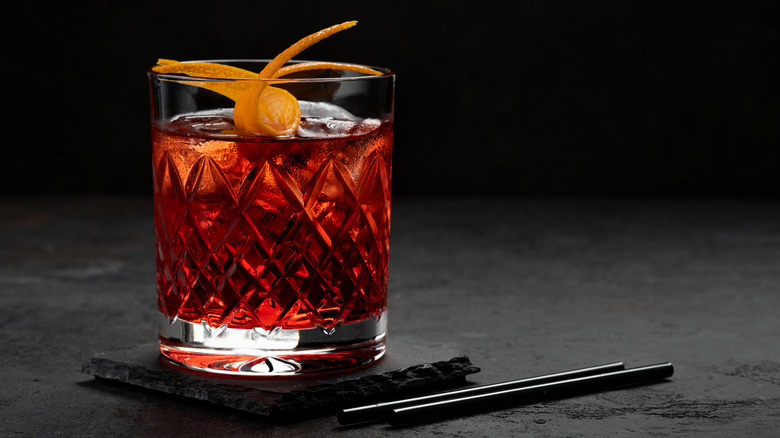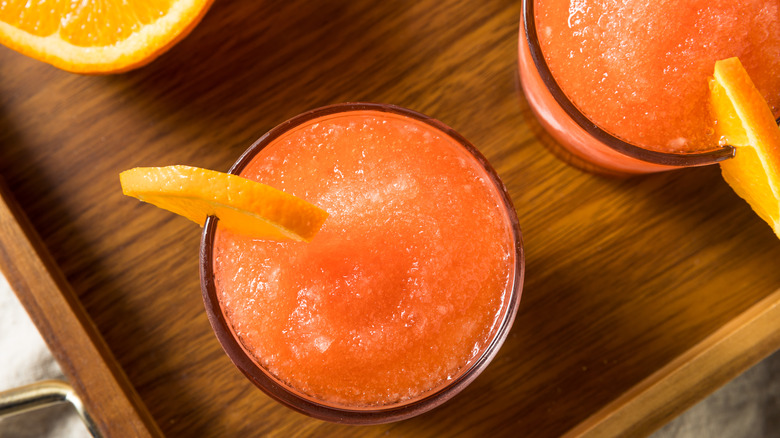Reasons You May Want To Consider Diluting Your Negroni
Aperol Spritzes tend to get the most credit in the lineup of Italian drinks. Glasses filled with orange Aperol pepper piazzas across Italy, while spritzes have become a mainstay at bars throughout the U.S. Spritzes are Italian cocktails that nicely complement Aperol's flavors when combined with ice, water, and prosecco (per Aperol's traditional recipe). Unlike spritzes, which balance the booze with extra ingredients, Negronis consist only of alcohol. But just because Negronis are all-liquor doesn't mean they have to come on strong.
A classic Negroni calls for equal parts gin, vermouth, and Campari, but you can alter your drink's flavors by whipping up a tailor-made cocktail. Many Negroni variations can give the drink an entirely different character. Adding espresso, for example, is a (still) trendy way will transform the drink's flavor. Or, you can opt for a textural and summer-worthy shift by freezing your Negroni. Traditional versions of Italian food and drink may be delicious, but there's no reason innovative iterations can't taste just as grand.
If your Negroni is a little too strong, maybe it's best to get back to the basics. Diluting your Negroni may very well be the key to converting even the most avid spritz fans to Negroni aficionados. Adding water and ice can not only weaken the drink to your preferred alcohol intensity, but serve other purposes as well. Watering down your cocktail will make whipping up — not to mention drinking — your next Negroni all the easier.
Diluting your drink prepares it for the freezer — and back
Remember that frozen Negroni variation? Well, whipping up a frozen Negroni has more than one meaning. Although frozen Negronis are suitable in slushy form, they can also be frozen — literally. Distiller recommends batch-making Negronis for your household freezer. These pre-made cocktails are great to have on deck for easy access the next time a craving strikes.
To freeze a batch successfully, however, you'll need to add a step — and water — to a standard Negroni recipe. "Anytime one is pre-batching cocktails, you want to add water dilution to the mix," Kim Haasarud, a mixologist and cocktail book author, told Distiller. "Water is such an integral part of a cocktail recipe, but it's usually not listed as an ingredient because one is stirring or shaking it with ice which adds the dilution there. Most cocktails should be diluted about 25 percent."
Per Haasarud, Negronis are especially prime for batch-freezing. Punch Drink recommends using ¾ ounces of water for each Negroni serving to dilute your cocktail ahead of time in the freezer. Negroni's are best with some dilution, though they don't require as much water as the likes of, say, a martini. This is because spirits like Campari and vermouth have a lower alcohol content than more potent liquors. As such, a little dilution goes a long way.
Diluting your Negroni minimizes the need for small ice cubes
Even if you're not freezing your Negroni, you still may want to consider diluting it. Depending on your ice cube situation, dilution may actually be essential to making, what Anthony Bourdain considered the perfect cocktail.
According to Food & Wine, users of small ice cubes can forgo diluting their Negronis. Small ice cubes melt quickly, adding water without adding a step. However, if your ice cubes are larger and less prone to melting — or, let's be honest, if you prefer your Negronis weak — pay attention to the following suggestion; Food & Wine recommends stirring your drink in a glass mixer to dilute it prior to straining. HuffPost clarifies that Negronis are made entirely of alcohol, so they are stirred, never shaken, with ice. This step allows the Negroni to dilute, rendering small ice cubes unnecessary.
So add water — or ice — to your Negroni whenever you're missing small ice cubes. While diluting isn't always essential, it's often a good idea. With just a little bit of water, you'll preserve the integrity and flavors of the Italian cocktail, whether it's from the freezer or made on the spot.


